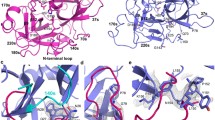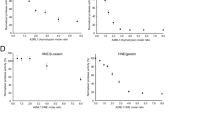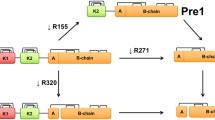Abstract
The human α2-plasmin inhibitor (A2PI) possesses unique N- and C-terminal extensions that significantly influence its biological activities. The C-terminal segment, A2PIC (Asn398-Lys452), contains six lysines thought to be involved in the binding to lysine-binding sites in the kringle domains of human plasminogen, of which four (Lys422, Lys429, Lys436, Lys452) are completely and two (Lys406, Lys415) are partially conserved. Multiple Lys to Ala mutants of A2PIC were expressed in Escherichia coli and used in intrinsic fluorescence titrations with kringle domains K1, K4, K4 + 5, and K1 + 2 + 3 of human plasminogen. We were able to identify the C-terminal Lys452 as the main binding partner in recombinant A2PIC (rA2PIC) constructs with isolated kringles. We could show a cooperative, zipper-like enhancement of the interaction between C-terminal Lys452 and internal Lys436 of rA2PIC and isolated K1 + 2 + 3, whereas the other internal lysine residues contribute only to a minor extent to the binding process. Sulfated Tyr445 in the unique C-terminal segment revealed no influence on the binding affinity to kringle domains.





Similar content being viewed by others
Abbreviations
- 6-AHA:
-
6-Aminohexanoic acid
- A2PI:
-
Human α2-plasmin inhibitor
- A2PIC:
-
C-terminal moiety of A2PI (Asn398-Lys452)
- rA2PIC:
-
Recombinant A2PIC (A2PIC/Pro399Ala)
- FXa :
-
Activated coagulation factor X
- His-tag:
-
Peptide MNHKVH6MELGTIEGR
- K1:
-
Kringle 1 of Pgn (Cys84-Cys162), generated as rK1 (Lys78-Glu164)
- K2:
-
Kringle 2 of Pgn (Cys166-Cys243), generated as rK2 (Cys162Thr/Glu163Ser/Glu164-Thr244/Cys169Gly)
- K3:
-
Kringle 3 of Pgn (Cys256-Cys333), generated as rK3 (Thr253-Ser335/Cys297Ser)
- rK3mut:
-
Mutated K3 domain of Pgn (rK3/Lys311Asp)
- K4:
-
Kringle 4 of Pgn (Cys358-Cys435), generated as fragment Val355-Ala440 of Pgn
- K5:
-
Kringle 5 of Pgn (Cys462-Cys541), generated as rK5 (Thr456-Ala543, Pro457Ala)
- K1–3:
-
Kringles 1–3 of Pgn (Cys84-Cys333), generated as fragment Tyr80-Val338 of Pgn
- K4–5:
-
Kringles 4–5 of Pgn (Cys358-Cys541), generated as rK4–5 (Val355-Phe546)
- LB Broth:
-
Luria–Bertani Broth
- LBS:
-
Lysine-binding site
- PAN:
-
Plasminogen N-terminal domain
- Pgn:
-
Human plasminogen
- Plm:
-
Human plasmin
- RCL:
-
Reactive center loop
- Serpin:
-
Serine protease inhibitor
- t-AMCHA:
-
trans-4-(Aminomethyl)cyclohexanecarboxylic acid
References
Lijnen HR, Wiman B, Collen D (1982) Partial primary structure of human alpha 2-antiplasmin-homology with other plasma protease inhibitors. Thromb Haemost 48:311–314
Collen D (1976) Identification and some properties of a new fast-reacting plasmin inhibitor in human plasma. Eur J Biochem 69:209–216
Moroi M, Aoki N (1976) Isolation and characterization of α2-plasmin inhibitor from human plasma. J Biol Chem 251:5956–5965
Müllertz S, Clemmensen I (1976) The primary inhibitor of plasmin in human plasma. Biochem J 159:545–553
Wiman B, Collen D (1977) Purification and characterization of human antiplasmin, the fast-acting plasmin inhibitor in plasma. Eur J Biochem 78:19–26
Sumi Y, Ichikawa Y, Nakamura Y, Miura O, Aoki N (1989) Expression and characterization of Pro α2-plasmin inhibitor. J Biochem 106:703–707
Saito H, Goodnough LT, Knowles BB, Aden DP (1982) Synthesis and secretion of α2-plasmin inhibitor by established human liver cell lines. Proc Natl Acad Sci 79:5684–5687
Locher M (2004) Strukturelle und funktionelle Untersuchungen am α2-Plasmininhibitor. Inauguraldissertation, Doctoral Dissertation, University of Bern, Switzerland
Ries M, Easton RL, Longstaff C, Zenker M, Morris HR, Dell A, Gaffney PJ (2002) Differences between neonates and adults in carbohydrate sequences and reaction kinetics of plasmin and α2-antiplasmin. Thromb Res 105:247–256
Lee KN, Jackson KW, Christiansen VJ, Chung KH, McKee PA (2004) A novel plasma proteinase potentiates α2-antiplasmin inhibition of fibrin digestion. Blood 103:3783–3788
Koyama T, Koike Y, Toyota S, Miyagi F, Suzuki N, Aoki N (1994) Different NH2-terminal form with 12 additional residues of α2-plasmin inhibitor from human plasma and culture media of Hep G2 cells. Biochem Biophys Res Commun 200:417–422
Tone M, Kikuno R, Kume-Iwaki A, Hashimoto-Gotoh T (1987) Structure of human α2-plasmin inhibitor deduced from the cDNA sequence. J Biochem 102:1033–1041
Holmes WE, Nelles L, Lijnen HR, Collen D (1987) Primary structure of human α2-antiplasmin, a serine protease inhibitor (serpin). J Biol Chem 262:1659–1664
Christensen S, Valnickova Z, Thøgersen IB, Olsen EH, Enghild JJ (1997) Assignment of a single disulphide bridge in human alpha2-antiplasmin: implications for the structural and functional properties. Biochem J 323:847–852
Hortin G, Fok KF, Toren PC, Strauss AW (1987) Sulfation of a tyrosine residue in the plasmin-binding domain of α2-antiplasmin. J Biol Chem 262:3082–3085
Kimura S, Aoki N (1986) Cross-linking site in fibrinogen for α2-plasmin inhibitor. J Biol Chem 261:15591–15595
Sakata Y, Aoki N (1982) Significance of cross-linking of α2-plasmin inhibitor to fibrin in inhibition of fibrinolysis and in hemostasis. J Clin Invest 69:536–542
Frank PS, Douglas JT, Locher M, Llinás M, Schaller J (2003) Structural/functional characterization of the α2-plasmin inhibitor C-terminal peptide. Biochemistry 42:1078–1085
Wiman B, Lijnen HR, Collen D (1979) On the specific interaction between the lysine-binding sites in plasmin and complementary sites in alpha2-antiplasmin and in fibrinogen. Biochim Biophys Acta 579:142–154
Sasaki T, Morita T, Iwanaga S (1986) Identification of the plasminogen-binding site of human alpha 2-plasmin inhibitor. J Biochem 99:1699–1705
Hortin GL, Gibson BL, Fok KF (1988) Alpha 2-antiplasmin’s carboxy-terminal lysine residue is a major site of interaction with plasmin. Biochem Biophys Res Commun 155:591–596
Law RH, Sofian T, Kan WT, Horvath AJ, Hitchen CR, Langendorf CG, Buckle AM, Whisstock JC, Coughlin PB (2008) X-ray crystal structure of the fibrinolysis inhibitor α2-antiplasmin. Blood 111:2049–2052
Raum D, Marcus D, Alper CA, Levey R, Taylor PD, Starzl TE (1980) Synthesis of human plasminogen by the liver. Science 208:1036–1037
Tordai H, Bányai L, Patthy L (1999) The PAN module: the N-terminal domains of plasminogen and hepatocyte growth factor are homologous with the apple domains of the prekallikrein family and with a novel domain found in numerous nematode proteins. FEBS Lett 461:63–67
Sottrup-Jensen L, Claeys H, Zajdel M, Petersen TE, Magnusson S (1978) In: Davidson JF, Rowan RM, Samama MM, Desnoyers PC (eds) Progress in chemical fibrinolysis and thrombolysis, vol 3. Raven Press, New York, pp 191-209
Wang X, Lin X, Loy JA, Tang J, Zhang XC (1998) Crystal structure of the catalytic domain of human plasmin complexed with streptokinase. Science 281:1662–1665
Ponting CP, Marshall JM, Cederholm-Williams SA (1992) Plasminogen: a structural review. Blood Coagul Fibrinolysis 3:605–614
Christensen U, Clemmensen I (1977) Kinetic properties of the primary inhibitor of plasmin from human plasma. Biochem J 163:389–391
Wiman B, Collen D (1978) On the kinetics of the reaction between human antiplasmin and plasmin. Eur J Biochem 84:573–578
Shieh B-H, Travis J (1987) The reactive site of human α2-antiplasmin. J Biol Chem 262:6055–6059
Wiman B, Boman L, Collen D (1978) On the kinetics of the reaction between human antiplasmin and a low-molecular-weight form of plasmin. Eur J Biochem 87:143–146
Wiman B, Collen D (1979) On the mechanism of the reaction between human alpha 2-antiplasmin and plasmin. J Biol Chem 254:9291–9297
Kluft C, Los P, Jie AF, van Hinsbergh VW, Vellenga E, Jespersen J, Henny CP (1986) The mutual relationship between the two molecular forms of the major fibrinolysis inhibitor alpha-2-antiplasmin in blood. Blood 67:616–622
Clemmensen I, Thorsen S, Müllertz S, Petersen LC (1981) Properties of three different molecular forms of the α2plasmin inhibitor. Eur J Biochem 120:105–112
Hortin GL, Trimpe BL, Fok KF (1989) Plasmin’s peptide-binding specificity: characterization of ligand sites in α2-antiplasmin. Thromb Res 54:621–632
Wang H, Yu A, Wiman B, Pap S (2003) Identification of amino acids in antiplasmin involved in its noncovalent ‘lysine-binding-site’-dependent interaction with plasmin. Eur J Biochem 270:2023–2029
Wang H, Karlsson A, Sjöström I, Wiman B (2006) The interaction between plasminogen and antiplasmin variants as studied by surface plasmon resonance. Biochim Biophys Acta 1764:1730–1734
Brunisholz R, Lerch P, Rickli EE (1979) Structural comparison between human, porcine and bovine plasminogen. In: Neri Serneri GG, Prentice CRM (eds) Haemostasis and thrombosis, vol 15. Academic press, London, pp 757–761
Novy R, Drott D, Yaeger K, Mierendorf R (2001) Overcoming the codon bias of E. coli for enhanced protein expression. inNovations 12:1–3
Qing G, Ma L-C, Khorchid A, Swapna GVT, Mal TK, Takayama MM, Xia B, Phadtare S, Ke H, Acton T, Montelione GT, Ikura M, Inouye M (2004) Cold-shock induced high-yield protein production in Escherichia coli. Nat Biotechnol 22:877–882
Bromfield KM, Quinsey NS, Duggan PJ, Pike RN (2006) Approaches to selective peptidic inhibitors of factor Xa. Chem Biol Drug Des 68:11–19
Ludeman JP, Pike RN, Bromfield KM, Duggan PJ, Cianci J, Le Bonniec B, Whisstock JC, Bottomley SP (2003) Determination of the P1′, P2′ and P3′ subsite-specificity of factor Xa. Int J Biochem Cell Biol 35:221–225
Sletta H, Tøndervik A, Hakvåg S, Vee Aune TE, Nedal A, Aune R, Evensen G, Valla S, Ellingsen TE, Brautaset T (2007) The presence of N-terminal secretion signal sequences leads to strong stimulation of the total expression levels of three tested medically important proteins during high-cell-density cultivations of Escherichia coli. Appl Environ Microbiol 73:906–912
Marti DN, Hu C-K, An SSA, von Haller P, Schaller J, Llinás M (1997) Ligand preferences of kringle 2 and homologous domains of human plasminogen: canvassing weak, intermediate, and high-affinity binding sites by 1H-NMR. Biochemistry 36:11591–11604
Marti D, Schaller J, Ochensberger B, Rickli E (1994) Expression, purification and characterization of the recombinant kringle 2 and kringle 3 domains of human plasminogen and analysis of their binding affinity for ω-aminocarboxylic acids. Eur J Biochem 219:455–462
Douglas JT, von Haller PD, Gehrmann M, Llinás M, Schaller J (2002) The two-domain NK1 fragment of plasminogen: folding, ligand binding, and thermal stability profile. Biochemistry 41:3302–3310
Chang J-Y, Knecht R (1991) Direct analysis of the disulfide content of proteins: methods for monitoring the stability and refolding process of cystine-containing proteins. Anal Biochem 197:52–58
Bidlingmeyer BA, Cohen SA, Tarvin TL (1984) Rapid analysis of amino acids using pre-column derivatization. J Chromatogr 336:93–104
Menhart N, Sehl LC, Kelley RF, Castellino FJ (1991) Construction, expression, and purification of recombinant kringle 1 of human plasminogen and analysis of its interaction with ω-amino acids. Biochemistry 30:1948–1957
Scatchard G (1949) The attractions of proteins for small molecules and ions. Ann N Y Acad Sci 51:660–672
Lejon S (2008) Human α2-plasmin inhibitor, a serpin with unique structural and functional properties. Doctoral Dissertation, University of Bern, Switzerland
Rejante MR (1992) Proton NMR studies on the structure and ligand-binding properties of human plasminogen kringles 1 and 4. Doctoral Dissertation, Carnegie Mellon University, Pittsburgh, PA
Petros AM, Ramesh V, Llinás M (1989) 1H NMR studies of aliphatic ligand binding to human plasminogen kringle 4. Biochemistry 28:1368–1376
Thewes T, Constantine K, Byeon I-JL, Llinás M (1990) Ligand interactions with the kringle 5 domain of plasminogen. JBC 265:3906–3915
Abad MC, Arni RK, Grella DK, Castellino FJ, Tulinsky A, Geiger JH (2002) The X-ray crystallographic structure of the angiogenesis inhibitor angiostatin. J Mol Biol 318:1009–1017
Sofian T, Horvath A, Hitchen C, Forsyth S, Coughlin P (2008) Antibody to the C-terminal extension of antiplasmin enhances fibrinolysis. In: Proceedings of the 5th international symposium on serpin biology, structure and function, serpins2008, Leuven, Belgium
Arnold K, Bordoli L, Kopp J, Schwede T (2006) The SWISS-MODEL Workspace: a web-based environment for protein structure homology modelling. Bioinformatics 22:195–201
Schwede T, Kopp J, Guex N, Peitsch MC (2003) SWISS-MODEL: an automated protein homology-modeling server. Nucleic Acids Res 31:3381–3385
Guex N, Peitsch MC (1997) SWISS-MODEL and the Swiss-PdbViewer: an environment for comparative protein modelling. Electrophoresis 18:2714–2723
Tranqui L, Prandini M-H, Chapel A (1979) The structure of plasminogen studied by electron Microscopy. Biol Cell 34:39–42
Weisel JW, Nagaswami C, Korsholm B, Petersen LC, Suenson E (1994) Interactions of plasminogen with polymerizing fibrin and its derivatives, monitored with a photoaffinity cross-linker and electron microscopy. J Mol Biol 235:1117–1135
Ho-Tin-Noé B, Rojas G, Vranckx R, Lijnen HR, Anglés-Cano E (2005) Functional hierarchy of plasminogen kringles 1 and 4 in fibrinolysis and plasmin-induced cell detachment and apoptosis. FEBS J 272:3387–3400
Huet E, Cauchard JH, Berton A, Robinet A, Decarme M, Hornebeck W, Bellon G (2004) Inhibition of plasmin-mediated prostromelysin-1 activation by interaction of long chain unsaturated fatty acids with kringle 5. Biochem Pharmacol 67:643–654
Cao Y, Chen A, An SS, Ji RW, Davidson D, Llinás M (1997) Kringle 5 of plasminogen is a novel inhibitor of endothelial cell growth. J Biol Chem 272:22924–22928
Gonzalez-Gronow M, Kalfa T, Johnson CE, Gawdi G, Pizzo SV (2003) The voltage-dependent anion channel is a receptor for plasminogen kringle 5 on human endothelial cells. J Biol Chem 278:27312–27318
Davidson DJ, Haskell C, Majest S, Kherzai A, Egan DA, Walter KA, Schneider A, Gubbins EF, Solomon L, Chen Z, Lesniewski R, Henkin J (2005) Kringle 5 of human plasminogen induces apoptosis of endothelial and tumor cells through surface-expressed glucose-regulated protein 78. Cancer Res 65:4663–4672
Acknowledgments
We would like to thank PD Dr. A. Walz (Theodor Kocher Institute, University of Bern, Switzerland) for the generation of the synthetic peptides A2PIC(Glu442-Lys452) with and without sulfated Tyr445, Prof. Dr. U. Baumann (University of Bern, Switzerland) for providing the pET22b(+) vector and Prof. L.-O. Hedén (University of Lund, Sweden) for supplying the pPLGKG plasmid. We also thank Mr. U. Kämpfer for expert technical assistance, Mr. Christian Trachsel for his support building the plasminogen model, and Mr. S. Halbherr and Mrs. A. Mori for performing fluorescence measurements during their bachelor theses.
Author information
Authors and Affiliations
Corresponding author
Rights and permissions
About this article
Cite this article
Gerber, S.S., Lejon, S., Locher, M. et al. The human α2-plasmin inhibitor: functional characterization of the unique plasmin(ogen)-binding region. Cell. Mol. Life Sci. 67, 1505–1518 (2010). https://doi.org/10.1007/s00018-010-0264-3
Received:
Revised:
Accepted:
Published:
Issue Date:
DOI: https://doi.org/10.1007/s00018-010-0264-3




